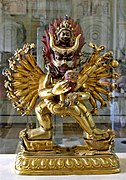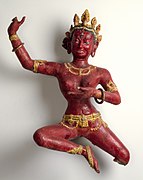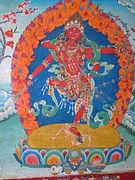
Vajrayāna, also known as Mantrayāna, Guhyamantrayāna, Tantrayāna, Secret Mantra, Tantric Buddhism, and Esoteric Buddhism, is a Buddhist tradition of tantric practice which developed in the medieval Indian subcontinent and spread to Tibet, Nepal, other Himalayan states, East Asia, and Mongolia.
A Wisdom King is a type of wrathful deity in East Asian Buddhism.
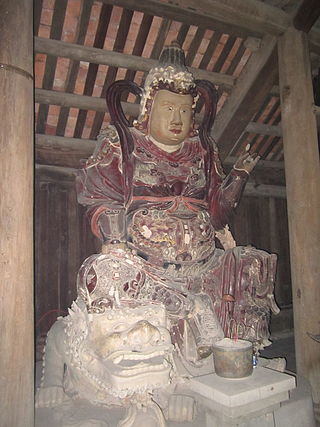
A dharmapāla is a type of wrathful god in Buddhism. The name means "dharma protector" in Sanskrit, and the dharmapālas are also known as the Defenders of the Justice (Dharma), or the Guardians of the Law. There are two kinds of dharmapala, Worldly Guardians (lokapala) and Wisdom Protectors (jnanapala). Only Wisdom Protectors are enlightened beings.

Vaiśravaṇa or Vessavaṇa, is one of the Four Heavenly Kings, and is considered an important figure in Buddhism. He is the god of warfare and usually portrayed as a warrior-king.

Buddhism includes a wide array of divine beings that are venerated in various ritual and popular contexts. Initially they included mainly Indian figures such as devas, asuras and yakshas, but later came to include other Asian spirits and local gods. They range from enlightened Buddhas to regional spirits adopted by Buddhists or practiced on the margins of the religion.
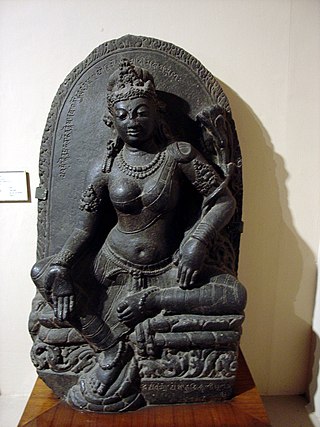
Tara, Ārya Tārā, or Shayama Tara, also known as Jetsun Dölma is an important figure in Buddhism, especially revered in Tibetan Buddhism. She appears as a female bodhisattva in Mahayana Buddhism, and as a female Buddha in Vajrayana Buddhism. She is known as the "mother of liberation", and represents the virtues of success in work and achievements. She is known as Duōluó Púsà (多羅菩薩) in Chinese Buddhism, and as Tara Bosatsu (多羅菩薩) in Japan.

Yamāntaka or Vajrabhairava is the "destroyer of death" deity of Vajrayana Buddhism. Sometimes he is conceptualized as "conqueror of the lord of death". Of the several deities in the Buddhist pantheon named 'Yamāntaka', the most well known, also called as 'Vajrabhairava' belongs to the Anuttarayoga Tantra class of deities popular within the Gelug school of Tibetan Buddhism.
A yidam or iṣṭadevatā is a type of deity associated with tantric or Vajrayana Buddhism said to be manifestations of Buddhahood or enlightened mind. During personal meditation (sādhana) practice, the yogi identifies their own form, attributes and mind with those of a yidam for the purpose of transformation. Yidam is sometimes translated by the terms "meditational deity" or "tutelary deity". Examples of yidams include the meditation deities Chakrasamvara, Kalachakra, Hevajra, Yamantaka, and Vajrayogini, all of whom have a distinctive iconography, mandala, mantra, rites of invocation and practice.
Heruka, is the name of a category of wrathful deities, enlightened beings in Vajrayana Buddhism that adopt a fierce countenance to benefit sentient beings. In East Asia, these are called Wisdom Kings.
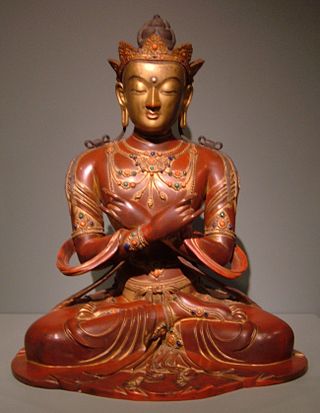
Vajradhara is the ultimate primordial Buddha, or Adi-Buddha, according to the Sakya, Gelug and Kagyu schools of Tibetan Buddhism. It is also a name of Indra, because "Vajra" means diamond, as well as the thunderbolt, or anything hard more generally.
Mahāyoga is the designation of the first of the three Inner Tantras according to the ninefold division of practice used by the Nyingma school of Tibetan Buddhism.

Ratnasambhava is one of the Five Dhyani Buddhas of Mahayana and Vajrayana or Tantric Buddhism. Ratnasambhava's mandalas and mantras focus on developing equanimity and equality and, in Vajrayana Buddhist thought is associated with the attempt to destroy greed and pride. His consort is Mamaki and his mount is a horse or a pair of lions.
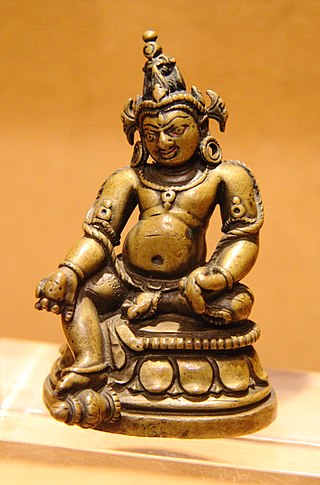
Jambhala is the God of Fortune and Wealth and appropriately a member of the Jewel Family. He is sometimes equated with the Hindu deity Kubera. Jambhala is also believed to be an emanation of Avalokitesvara or Chenrezig, the Bodhisattva of Compassion. There are five different wealth Jambhalas; each has his own practice and mantra to help eliminate poverty and create financial stability.
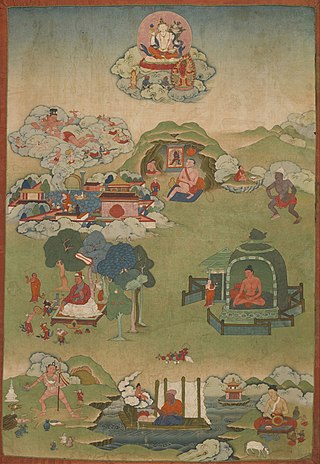
Tibetan tantric practice, also known as "the practice of secret mantra", and "tantric techniques", refers to the main tantric practices in Tibetan Buddhism. The great Rime scholar Jamgön Kongtrül refers to this as "the Process of Meditation in the Indestructible Way of Secret Mantra" and also as "the way of mantra," "way of method" and "the secret way" in his Treasury of Knowledge. These Vajrayāna Buddhist practices are mainly drawn from the Buddhist tantras and are generally not found in "common" Mahayana. These practices are seen by Tibetan Buddhists as the fastest and most powerful path to Buddhahood.
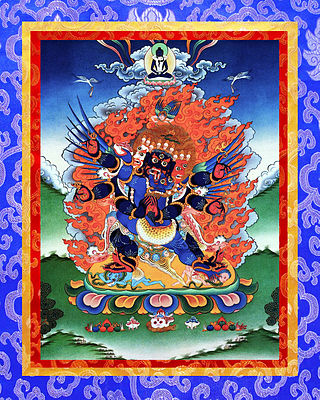
In Tibetan Buddhism, Vajrakilaya or Vajrakumara is a wrathful heruka yidam deity who embodies the enlightened activity of all the Buddhas. His practice is known for being the most powerful for removing obstacles and destroying the forces hostile to compassion. Vajrakilaya is one of the eight deities of Kagyé.
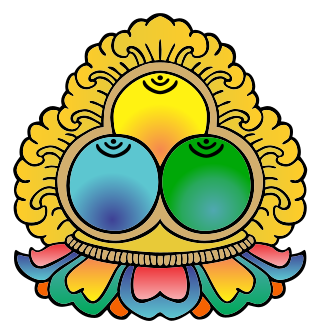
In Tibetan Buddhism, the Three Jewels and Three Roots are supports in which a Buddhist takes refuge by means of a prayer or recitation at the beginning of the day or of a practice session. The Three Jewels are the first and the Three Roots are the second set of three Tibetan Buddhist refuge formulations, the Outer, Inner and Secret forms of the Three Jewels. The 'Outer' form is the 'Triple Gem', (Sanskrit:triratna), the 'Inner' is the Three Roots and the 'Secret' form is the 'Three Bodies' or trikāya of a Buddha.

Kundali or Amritakundalin, also known in Chinese as Juntuli Mingwang and in Japanese as Gundari Myōō (軍荼利明王), is a wrathful deity and dharmapala in East Asian Esoteric Buddhism.

The Japanese Buddhist Pantheon designates the multitude of various Buddhas, Bodhisattvas and lesser deities and eminent religious masters in Buddhism. A Buddhist Pantheon exists to a certain extent in Mahāyāna, but is especially characteristic of Vajrayana Esoteric Buddhism, including Tibetan Buddhism and especially Japanese Shingon Buddhism, which formalized it to a great extent. In the ancient Japanese Buddhist Pantheon, more than 3,000 Buddhas or deities have been counted, although nowadays most temples focus on one Buddha and a few Bodhisattvas.


